Analyzing HR Challenges & Retention Strategies in Construction Sector
VerifiedAdded on 2023/06/04
|13
|3771
|101
Essay
AI Summary
This essay discusses the human resource challenges faced by the construction sector, including high turnover rates, difficulties in attracting and retaining employees with high potential, and the failure to understand employee needs. It identifies challenges such as talent mobility, lack of job security, career blockage, and safety concerns. The essay attributes these challenges to long working hours, limited growth prospects, poor payment structures, health hazards, and lack of job security. To improve employee attraction and retention, the essay suggests strategies such as prioritizing company fit, implementing apprenticeship programs, ensuring steady recruitment, providing flexible working schedules, developing employee orientation programs, and establishing mentorship programs. The analysis highlights the importance of addressing both hygiene and motivating factors to foster a positive work environment and build trust between employees and senior leadership, ultimately reducing turnover and enhancing organizational success. Desklib provides access to this assignment and other study resources for students.
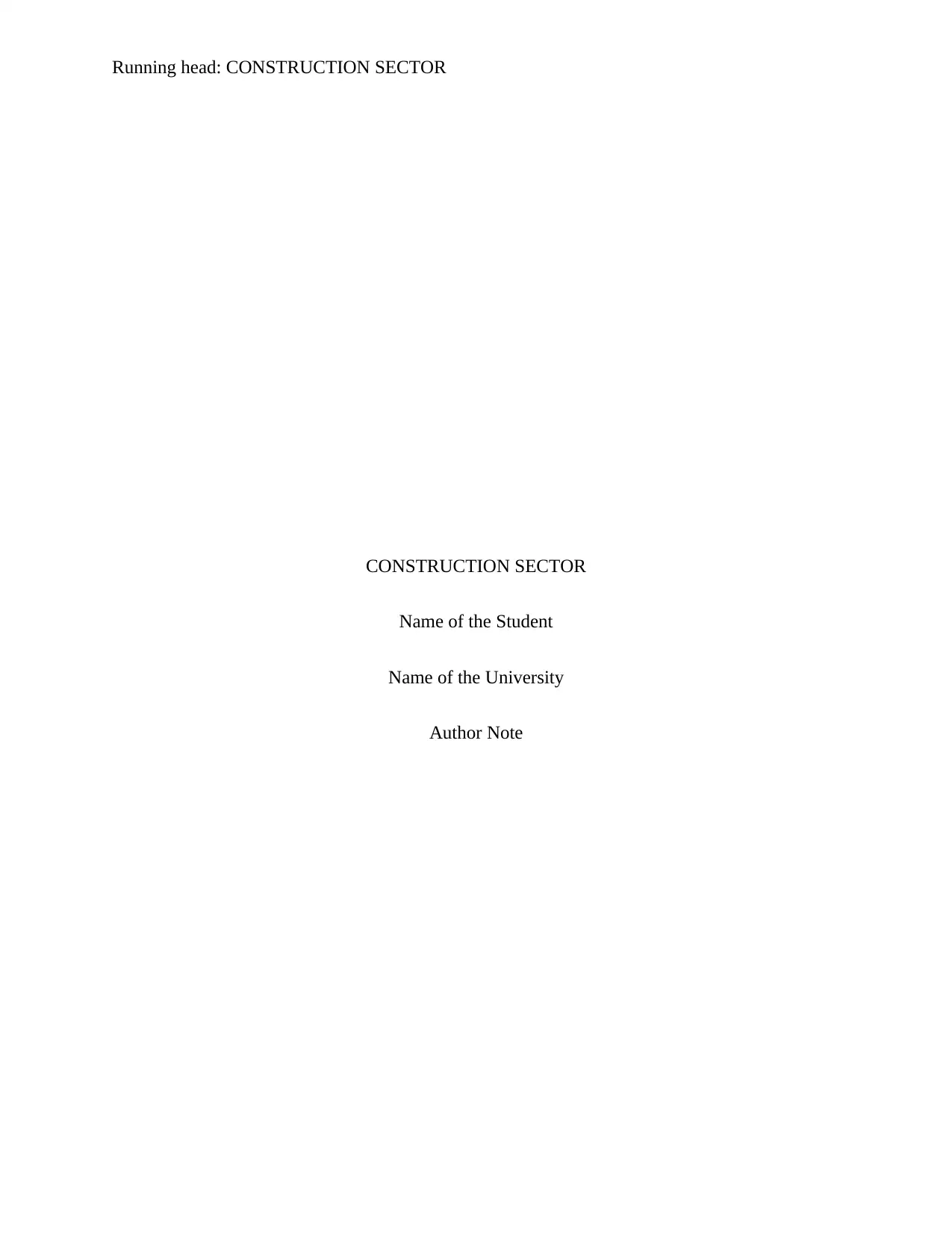
Running head: CONSTRUCTION SECTOR
CONSTRUCTION SECTOR
Name of the Student
Name of the University
Author Note
CONSTRUCTION SECTOR
Name of the Student
Name of the University
Author Note
Paraphrase This Document
Need a fresh take? Get an instant paraphrase of this document with our AI Paraphraser
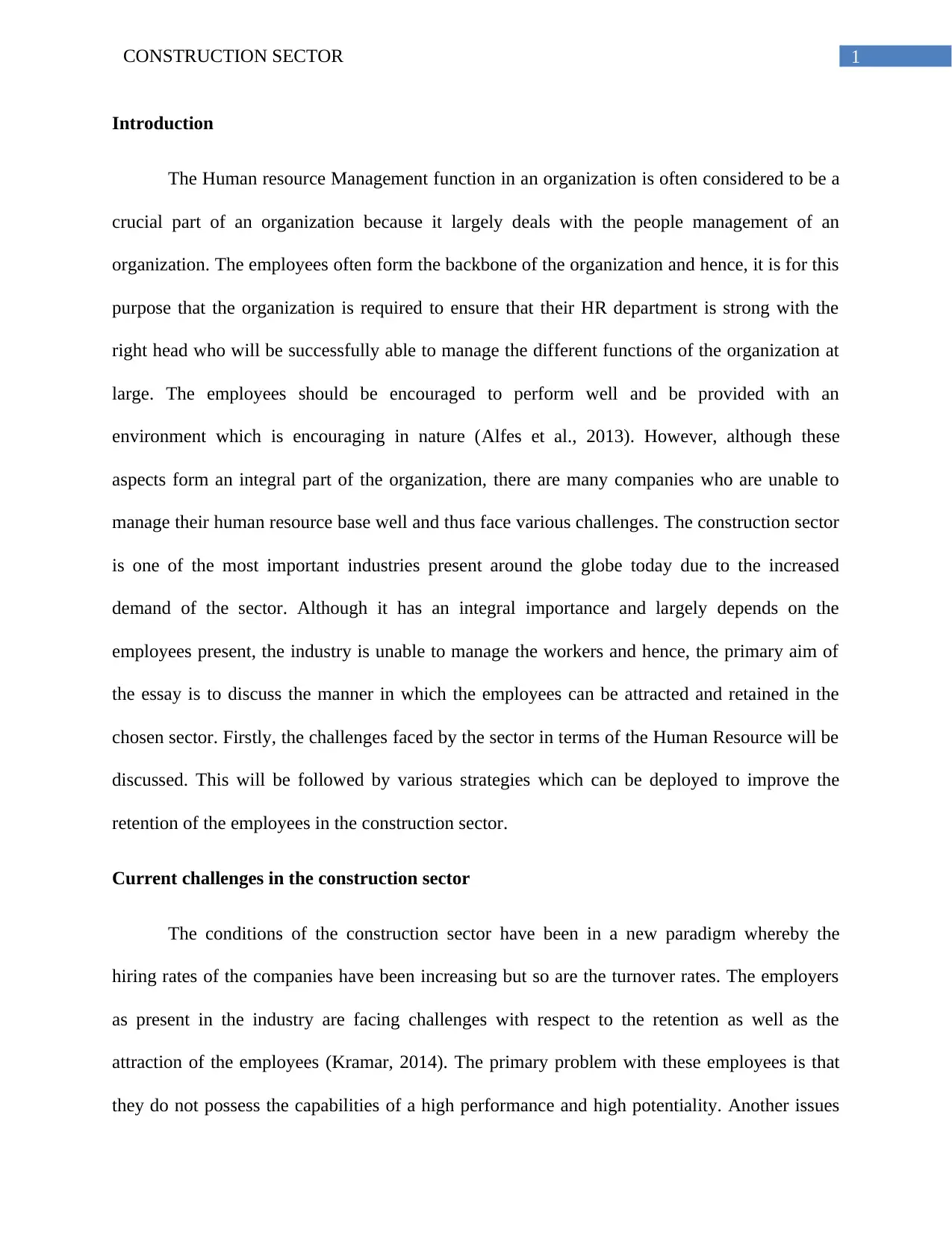
1CONSTRUCTION SECTOR
Introduction
The Human resource Management function in an organization is often considered to be a
crucial part of an organization because it largely deals with the people management of an
organization. The employees often form the backbone of the organization and hence, it is for this
purpose that the organization is required to ensure that their HR department is strong with the
right head who will be successfully able to manage the different functions of the organization at
large. The employees should be encouraged to perform well and be provided with an
environment which is encouraging in nature (Alfes et al., 2013). However, although these
aspects form an integral part of the organization, there are many companies who are unable to
manage their human resource base well and thus face various challenges. The construction sector
is one of the most important industries present around the globe today due to the increased
demand of the sector. Although it has an integral importance and largely depends on the
employees present, the industry is unable to manage the workers and hence, the primary aim of
the essay is to discuss the manner in which the employees can be attracted and retained in the
chosen sector. Firstly, the challenges faced by the sector in terms of the Human Resource will be
discussed. This will be followed by various strategies which can be deployed to improve the
retention of the employees in the construction sector.
Current challenges in the construction sector
The conditions of the construction sector have been in a new paradigm whereby the
hiring rates of the companies have been increasing but so are the turnover rates. The employers
as present in the industry are facing challenges with respect to the retention as well as the
attraction of the employees (Kramar, 2014). The primary problem with these employees is that
they do not possess the capabilities of a high performance and high potentiality. Another issues
Introduction
The Human resource Management function in an organization is often considered to be a
crucial part of an organization because it largely deals with the people management of an
organization. The employees often form the backbone of the organization and hence, it is for this
purpose that the organization is required to ensure that their HR department is strong with the
right head who will be successfully able to manage the different functions of the organization at
large. The employees should be encouraged to perform well and be provided with an
environment which is encouraging in nature (Alfes et al., 2013). However, although these
aspects form an integral part of the organization, there are many companies who are unable to
manage their human resource base well and thus face various challenges. The construction sector
is one of the most important industries present around the globe today due to the increased
demand of the sector. Although it has an integral importance and largely depends on the
employees present, the industry is unable to manage the workers and hence, the primary aim of
the essay is to discuss the manner in which the employees can be attracted and retained in the
chosen sector. Firstly, the challenges faced by the sector in terms of the Human Resource will be
discussed. This will be followed by various strategies which can be deployed to improve the
retention of the employees in the construction sector.
Current challenges in the construction sector
The conditions of the construction sector have been in a new paradigm whereby the
hiring rates of the companies have been increasing but so are the turnover rates. The employers
as present in the industry are facing challenges with respect to the retention as well as the
attraction of the employees (Kramar, 2014). The primary problem with these employees is that
they do not possess the capabilities of a high performance and high potentiality. Another issues
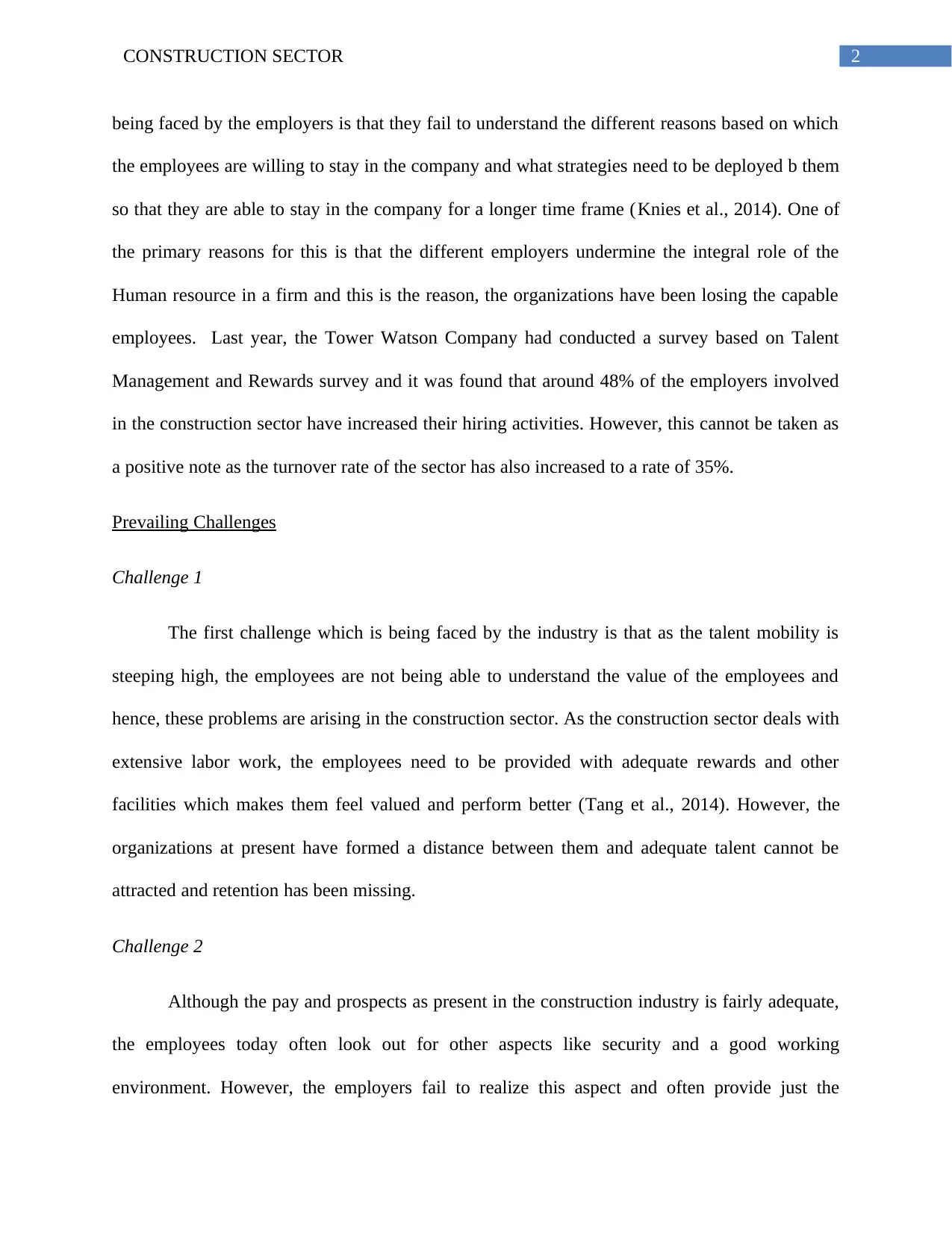
2CONSTRUCTION SECTOR
being faced by the employers is that they fail to understand the different reasons based on which
the employees are willing to stay in the company and what strategies need to be deployed b them
so that they are able to stay in the company for a longer time frame (Knies et al., 2014). One of
the primary reasons for this is that the different employers undermine the integral role of the
Human resource in a firm and this is the reason, the organizations have been losing the capable
employees. Last year, the Tower Watson Company had conducted a survey based on Talent
Management and Rewards survey and it was found that around 48% of the employers involved
in the construction sector have increased their hiring activities. However, this cannot be taken as
a positive note as the turnover rate of the sector has also increased to a rate of 35%.
Prevailing Challenges
Challenge 1
The first challenge which is being faced by the industry is that as the talent mobility is
steeping high, the employees are not being able to understand the value of the employees and
hence, these problems are arising in the construction sector. As the construction sector deals with
extensive labor work, the employees need to be provided with adequate rewards and other
facilities which makes them feel valued and perform better (Tang et al., 2014). However, the
organizations at present have formed a distance between them and adequate talent cannot be
attracted and retention has been missing.
Challenge 2
Although the pay and prospects as present in the construction industry is fairly adequate,
the employees today often look out for other aspects like security and a good working
environment. However, the employers fail to realize this aspect and often provide just the
being faced by the employers is that they fail to understand the different reasons based on which
the employees are willing to stay in the company and what strategies need to be deployed b them
so that they are able to stay in the company for a longer time frame (Knies et al., 2014). One of
the primary reasons for this is that the different employers undermine the integral role of the
Human resource in a firm and this is the reason, the organizations have been losing the capable
employees. Last year, the Tower Watson Company had conducted a survey based on Talent
Management and Rewards survey and it was found that around 48% of the employers involved
in the construction sector have increased their hiring activities. However, this cannot be taken as
a positive note as the turnover rate of the sector has also increased to a rate of 35%.
Prevailing Challenges
Challenge 1
The first challenge which is being faced by the industry is that as the talent mobility is
steeping high, the employees are not being able to understand the value of the employees and
hence, these problems are arising in the construction sector. As the construction sector deals with
extensive labor work, the employees need to be provided with adequate rewards and other
facilities which makes them feel valued and perform better (Tang et al., 2014). However, the
organizations at present have formed a distance between them and adequate talent cannot be
attracted and retention has been missing.
Challenge 2
Although the pay and prospects as present in the construction industry is fairly adequate,
the employees today often look out for other aspects like security and a good working
environment. However, the employers fail to realize this aspect and often provide just the
⊘ This is a preview!⊘
Do you want full access?
Subscribe today to unlock all pages.

Trusted by 1+ million students worldwide
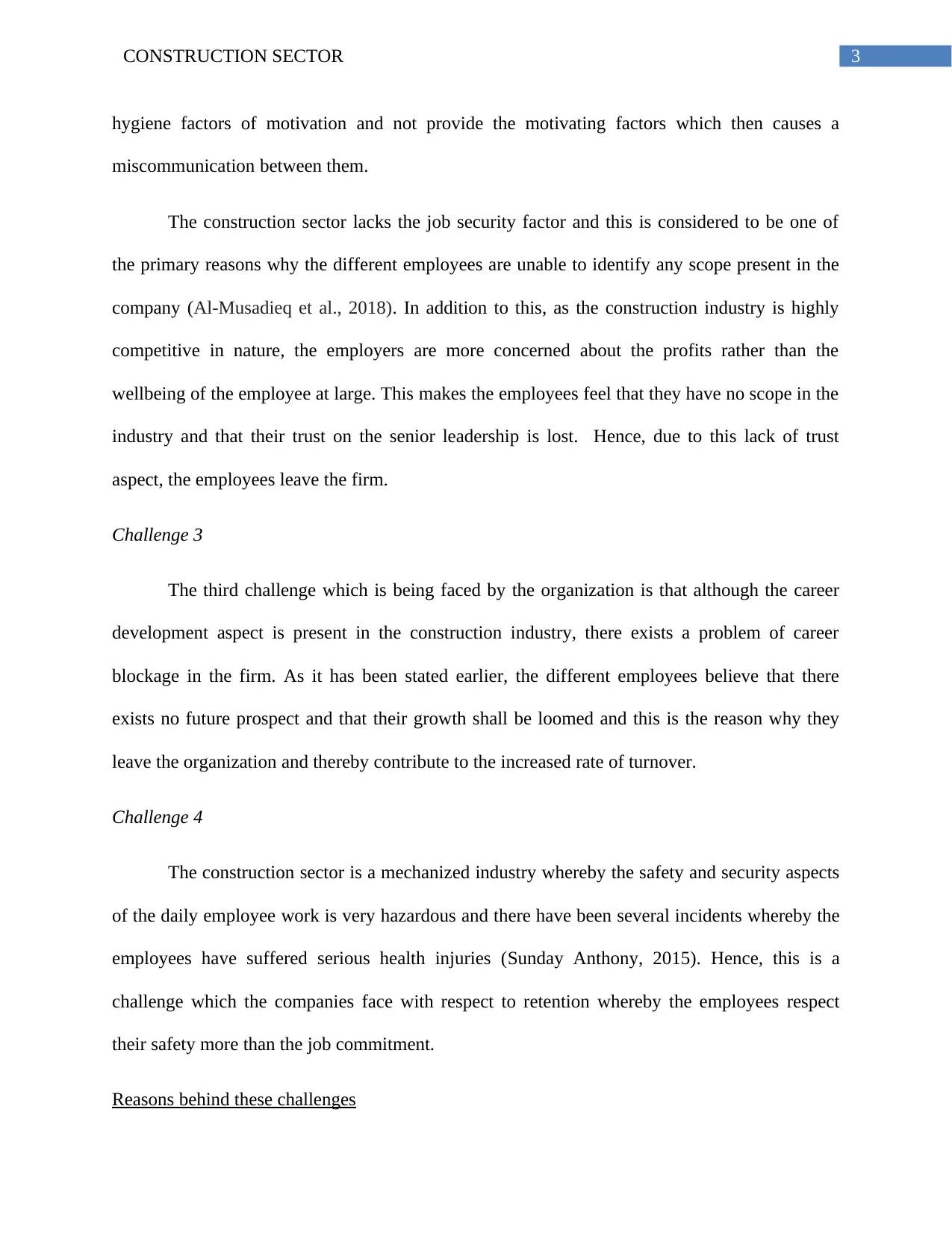
3CONSTRUCTION SECTOR
hygiene factors of motivation and not provide the motivating factors which then causes a
miscommunication between them.
The construction sector lacks the job security factor and this is considered to be one of
the primary reasons why the different employees are unable to identify any scope present in the
company (Al-Musadieq et al., 2018). In addition to this, as the construction industry is highly
competitive in nature, the employers are more concerned about the profits rather than the
wellbeing of the employee at large. This makes the employees feel that they have no scope in the
industry and that their trust on the senior leadership is lost. Hence, due to this lack of trust
aspect, the employees leave the firm.
Challenge 3
The third challenge which is being faced by the organization is that although the career
development aspect is present in the construction industry, there exists a problem of career
blockage in the firm. As it has been stated earlier, the different employees believe that there
exists no future prospect and that their growth shall be loomed and this is the reason why they
leave the organization and thereby contribute to the increased rate of turnover.
Challenge 4
The construction sector is a mechanized industry whereby the safety and security aspects
of the daily employee work is very hazardous and there have been several incidents whereby the
employees have suffered serious health injuries (Sunday Anthony, 2015). Hence, this is a
challenge which the companies face with respect to retention whereby the employees respect
their safety more than the job commitment.
Reasons behind these challenges
hygiene factors of motivation and not provide the motivating factors which then causes a
miscommunication between them.
The construction sector lacks the job security factor and this is considered to be one of
the primary reasons why the different employees are unable to identify any scope present in the
company (Al-Musadieq et al., 2018). In addition to this, as the construction industry is highly
competitive in nature, the employers are more concerned about the profits rather than the
wellbeing of the employee at large. This makes the employees feel that they have no scope in the
industry and that their trust on the senior leadership is lost. Hence, due to this lack of trust
aspect, the employees leave the firm.
Challenge 3
The third challenge which is being faced by the organization is that although the career
development aspect is present in the construction industry, there exists a problem of career
blockage in the firm. As it has been stated earlier, the different employees believe that there
exists no future prospect and that their growth shall be loomed and this is the reason why they
leave the organization and thereby contribute to the increased rate of turnover.
Challenge 4
The construction sector is a mechanized industry whereby the safety and security aspects
of the daily employee work is very hazardous and there have been several incidents whereby the
employees have suffered serious health injuries (Sunday Anthony, 2015). Hence, this is a
challenge which the companies face with respect to retention whereby the employees respect
their safety more than the job commitment.
Reasons behind these challenges
Paraphrase This Document
Need a fresh take? Get an instant paraphrase of this document with our AI Paraphraser
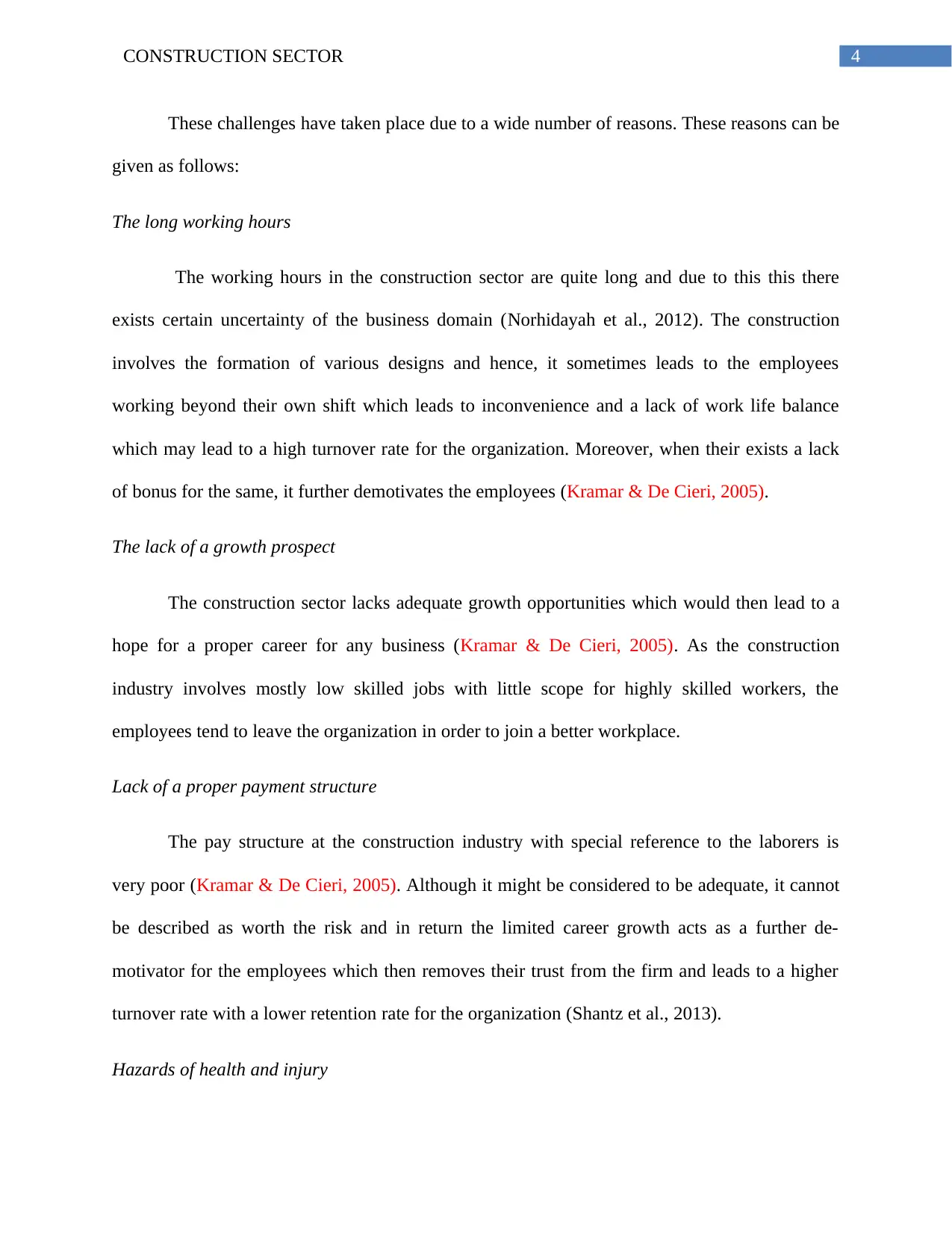
4CONSTRUCTION SECTOR
These challenges have taken place due to a wide number of reasons. These reasons can be
given as follows:
The long working hours
The working hours in the construction sector are quite long and due to this this there
exists certain uncertainty of the business domain (Norhidayah et al., 2012). The construction
involves the formation of various designs and hence, it sometimes leads to the employees
working beyond their own shift which leads to inconvenience and a lack of work life balance
which may lead to a high turnover rate for the organization. Moreover, when their exists a lack
of bonus for the same, it further demotivates the employees (Kramar & De Cieri, 2005).
The lack of a growth prospect
The construction sector lacks adequate growth opportunities which would then lead to a
hope for a proper career for any business (Kramar & De Cieri, 2005). As the construction
industry involves mostly low skilled jobs with little scope for highly skilled workers, the
employees tend to leave the organization in order to join a better workplace.
Lack of a proper payment structure
The pay structure at the construction industry with special reference to the laborers is
very poor (Kramar & De Cieri, 2005). Although it might be considered to be adequate, it cannot
be described as worth the risk and in return the limited career growth acts as a further de-
motivator for the employees which then removes their trust from the firm and leads to a higher
turnover rate with a lower retention rate for the organization (Shantz et al., 2013).
Hazards of health and injury
These challenges have taken place due to a wide number of reasons. These reasons can be
given as follows:
The long working hours
The working hours in the construction sector are quite long and due to this this there
exists certain uncertainty of the business domain (Norhidayah et al., 2012). The construction
involves the formation of various designs and hence, it sometimes leads to the employees
working beyond their own shift which leads to inconvenience and a lack of work life balance
which may lead to a high turnover rate for the organization. Moreover, when their exists a lack
of bonus for the same, it further demotivates the employees (Kramar & De Cieri, 2005).
The lack of a growth prospect
The construction sector lacks adequate growth opportunities which would then lead to a
hope for a proper career for any business (Kramar & De Cieri, 2005). As the construction
industry involves mostly low skilled jobs with little scope for highly skilled workers, the
employees tend to leave the organization in order to join a better workplace.
Lack of a proper payment structure
The pay structure at the construction industry with special reference to the laborers is
very poor (Kramar & De Cieri, 2005). Although it might be considered to be adequate, it cannot
be described as worth the risk and in return the limited career growth acts as a further de-
motivator for the employees which then removes their trust from the firm and leads to a higher
turnover rate with a lower retention rate for the organization (Shantz et al., 2013).
Hazards of health and injury
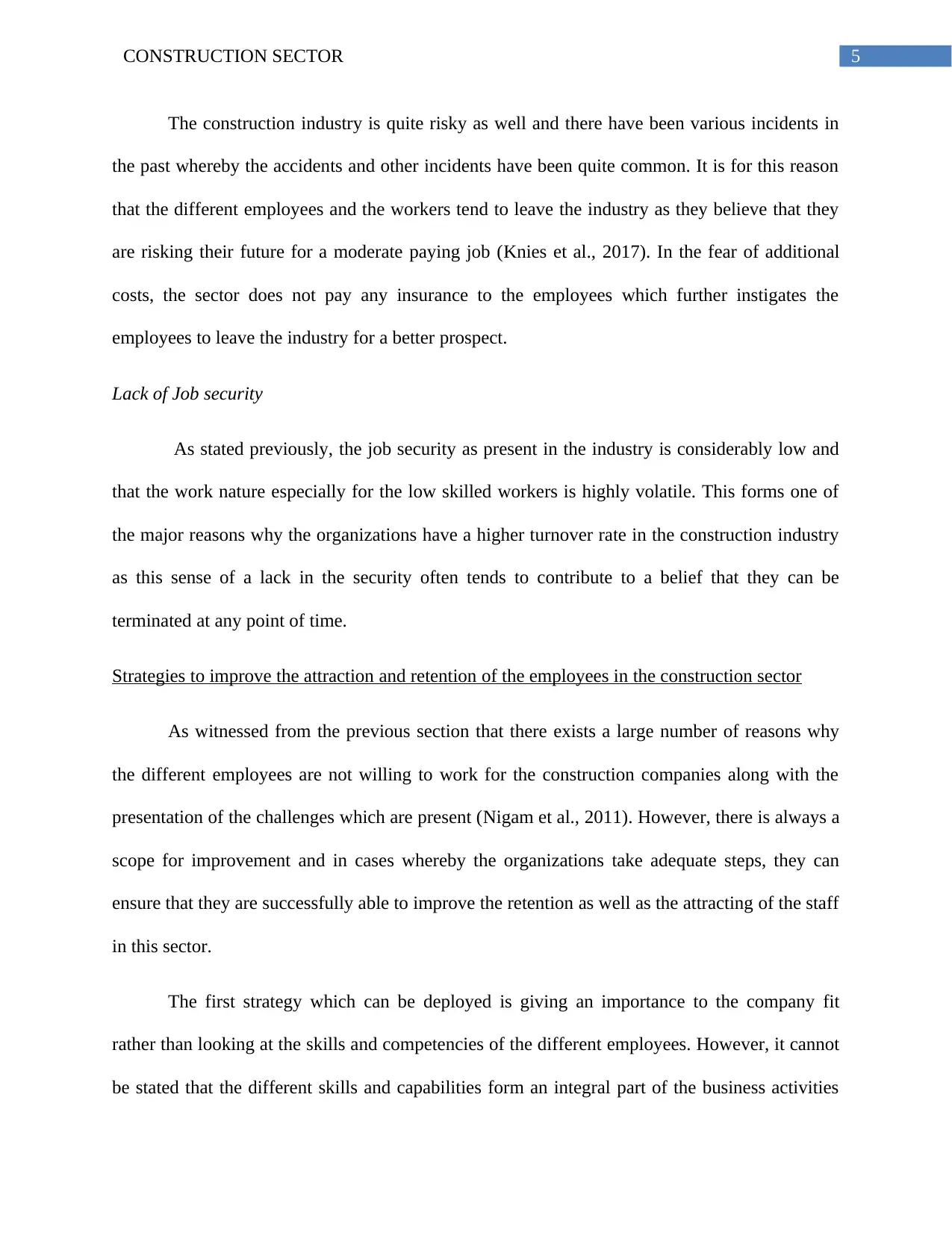
5CONSTRUCTION SECTOR
The construction industry is quite risky as well and there have been various incidents in
the past whereby the accidents and other incidents have been quite common. It is for this reason
that the different employees and the workers tend to leave the industry as they believe that they
are risking their future for a moderate paying job (Knies et al., 2017). In the fear of additional
costs, the sector does not pay any insurance to the employees which further instigates the
employees to leave the industry for a better prospect.
Lack of Job security
As stated previously, the job security as present in the industry is considerably low and
that the work nature especially for the low skilled workers is highly volatile. This forms one of
the major reasons why the organizations have a higher turnover rate in the construction industry
as this sense of a lack in the security often tends to contribute to a belief that they can be
terminated at any point of time.
Strategies to improve the attraction and retention of the employees in the construction sector
As witnessed from the previous section that there exists a large number of reasons why
the different employees are not willing to work for the construction companies along with the
presentation of the challenges which are present (Nigam et al., 2011). However, there is always a
scope for improvement and in cases whereby the organizations take adequate steps, they can
ensure that they are successfully able to improve the retention as well as the attracting of the staff
in this sector.
The first strategy which can be deployed is giving an importance to the company fit
rather than looking at the skills and competencies of the different employees. However, it cannot
be stated that the different skills and capabilities form an integral part of the business activities
The construction industry is quite risky as well and there have been various incidents in
the past whereby the accidents and other incidents have been quite common. It is for this reason
that the different employees and the workers tend to leave the industry as they believe that they
are risking their future for a moderate paying job (Knies et al., 2017). In the fear of additional
costs, the sector does not pay any insurance to the employees which further instigates the
employees to leave the industry for a better prospect.
Lack of Job security
As stated previously, the job security as present in the industry is considerably low and
that the work nature especially for the low skilled workers is highly volatile. This forms one of
the major reasons why the organizations have a higher turnover rate in the construction industry
as this sense of a lack in the security often tends to contribute to a belief that they can be
terminated at any point of time.
Strategies to improve the attraction and retention of the employees in the construction sector
As witnessed from the previous section that there exists a large number of reasons why
the different employees are not willing to work for the construction companies along with the
presentation of the challenges which are present (Nigam et al., 2011). However, there is always a
scope for improvement and in cases whereby the organizations take adequate steps, they can
ensure that they are successfully able to improve the retention as well as the attracting of the staff
in this sector.
The first strategy which can be deployed is giving an importance to the company fit
rather than looking at the skills and competencies of the different employees. However, it cannot
be stated that the different skills and capabilities form an integral part of the business activities
⊘ This is a preview!⊘
Do you want full access?
Subscribe today to unlock all pages.

Trusted by 1+ million students worldwide
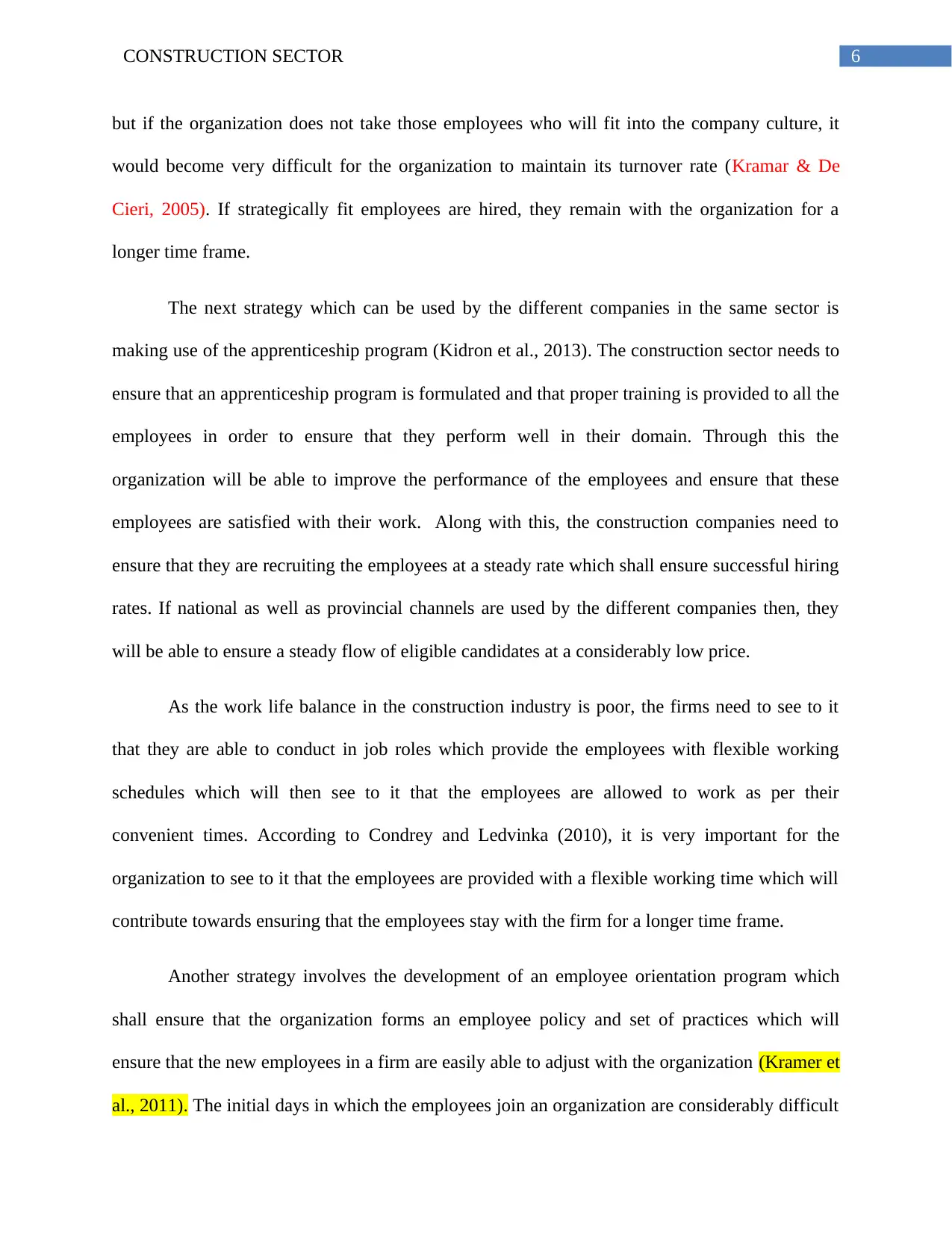
6CONSTRUCTION SECTOR
but if the organization does not take those employees who will fit into the company culture, it
would become very difficult for the organization to maintain its turnover rate (Kramar & De
Cieri, 2005). If strategically fit employees are hired, they remain with the organization for a
longer time frame.
The next strategy which can be used by the different companies in the same sector is
making use of the apprenticeship program (Kidron et al., 2013). The construction sector needs to
ensure that an apprenticeship program is formulated and that proper training is provided to all the
employees in order to ensure that they perform well in their domain. Through this the
organization will be able to improve the performance of the employees and ensure that these
employees are satisfied with their work. Along with this, the construction companies need to
ensure that they are recruiting the employees at a steady rate which shall ensure successful hiring
rates. If national as well as provincial channels are used by the different companies then, they
will be able to ensure a steady flow of eligible candidates at a considerably low price.
As the work life balance in the construction industry is poor, the firms need to see to it
that they are able to conduct in job roles which provide the employees with flexible working
schedules which will then see to it that the employees are allowed to work as per their
convenient times. According to Condrey and Ledvinka (2010), it is very important for the
organization to see to it that the employees are provided with a flexible working time which will
contribute towards ensuring that the employees stay with the firm for a longer time frame.
Another strategy involves the development of an employee orientation program which
shall ensure that the organization forms an employee policy and set of practices which will
ensure that the new employees in a firm are easily able to adjust with the organization (Kramer et
al., 2011). The initial days in which the employees join an organization are considerably difficult
but if the organization does not take those employees who will fit into the company culture, it
would become very difficult for the organization to maintain its turnover rate (Kramar & De
Cieri, 2005). If strategically fit employees are hired, they remain with the organization for a
longer time frame.
The next strategy which can be used by the different companies in the same sector is
making use of the apprenticeship program (Kidron et al., 2013). The construction sector needs to
ensure that an apprenticeship program is formulated and that proper training is provided to all the
employees in order to ensure that they perform well in their domain. Through this the
organization will be able to improve the performance of the employees and ensure that these
employees are satisfied with their work. Along with this, the construction companies need to
ensure that they are recruiting the employees at a steady rate which shall ensure successful hiring
rates. If national as well as provincial channels are used by the different companies then, they
will be able to ensure a steady flow of eligible candidates at a considerably low price.
As the work life balance in the construction industry is poor, the firms need to see to it
that they are able to conduct in job roles which provide the employees with flexible working
schedules which will then see to it that the employees are allowed to work as per their
convenient times. According to Condrey and Ledvinka (2010), it is very important for the
organization to see to it that the employees are provided with a flexible working time which will
contribute towards ensuring that the employees stay with the firm for a longer time frame.
Another strategy involves the development of an employee orientation program which
shall ensure that the organization forms an employee policy and set of practices which will
ensure that the new employees in a firm are easily able to adjust with the organization (Kramer et
al., 2011). The initial days in which the employees join an organization are considerably difficult
Paraphrase This Document
Need a fresh take? Get an instant paraphrase of this document with our AI Paraphraser
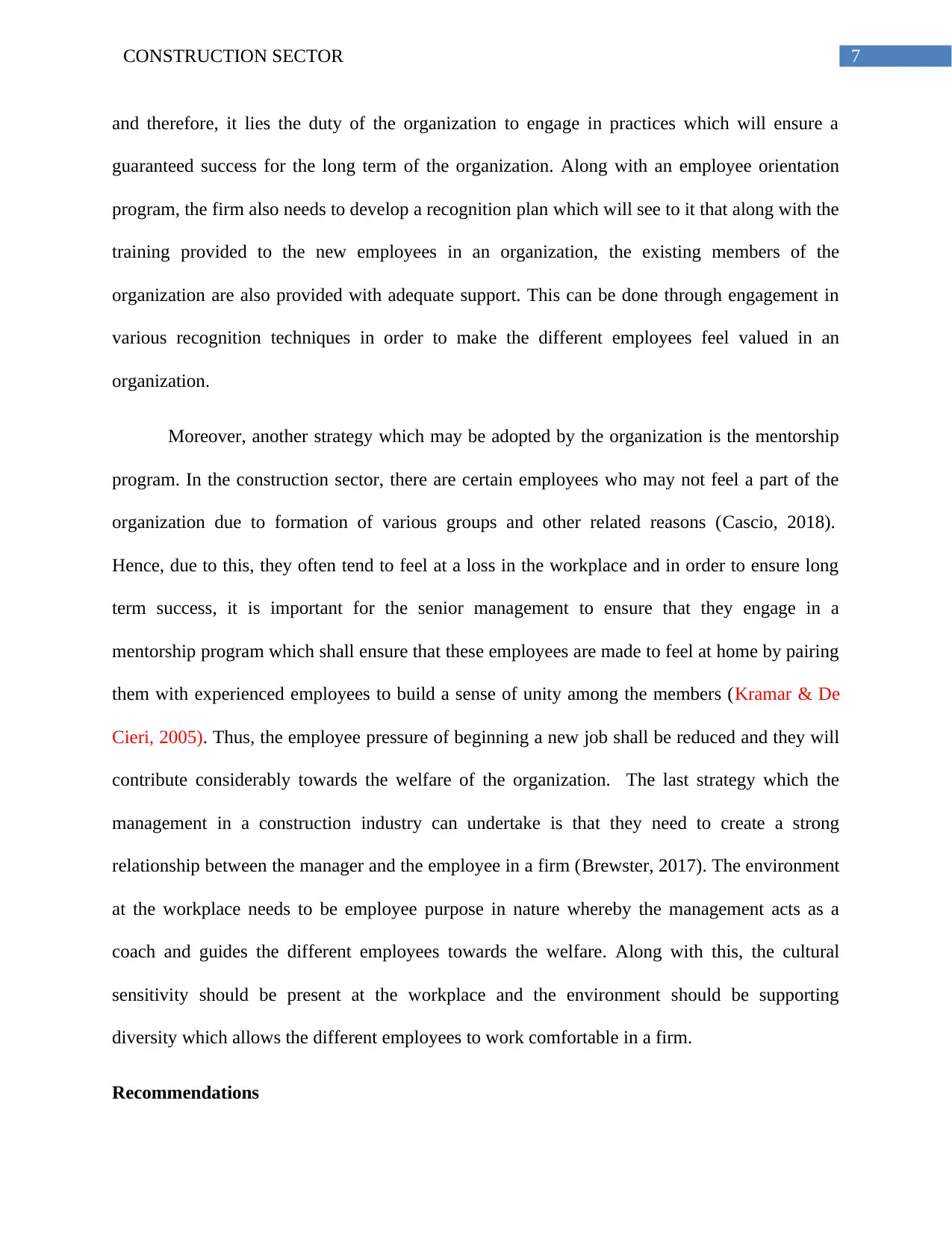
7CONSTRUCTION SECTOR
and therefore, it lies the duty of the organization to engage in practices which will ensure a
guaranteed success for the long term of the organization. Along with an employee orientation
program, the firm also needs to develop a recognition plan which will see to it that along with the
training provided to the new employees in an organization, the existing members of the
organization are also provided with adequate support. This can be done through engagement in
various recognition techniques in order to make the different employees feel valued in an
organization.
Moreover, another strategy which may be adopted by the organization is the mentorship
program. In the construction sector, there are certain employees who may not feel a part of the
organization due to formation of various groups and other related reasons (Cascio, 2018).
Hence, due to this, they often tend to feel at a loss in the workplace and in order to ensure long
term success, it is important for the senior management to ensure that they engage in a
mentorship program which shall ensure that these employees are made to feel at home by pairing
them with experienced employees to build a sense of unity among the members (Kramar & De
Cieri, 2005). Thus, the employee pressure of beginning a new job shall be reduced and they will
contribute considerably towards the welfare of the organization. The last strategy which the
management in a construction industry can undertake is that they need to create a strong
relationship between the manager and the employee in a firm (Brewster, 2017). The environment
at the workplace needs to be employee purpose in nature whereby the management acts as a
coach and guides the different employees towards the welfare. Along with this, the cultural
sensitivity should be present at the workplace and the environment should be supporting
diversity which allows the different employees to work comfortable in a firm.
Recommendations
and therefore, it lies the duty of the organization to engage in practices which will ensure a
guaranteed success for the long term of the organization. Along with an employee orientation
program, the firm also needs to develop a recognition plan which will see to it that along with the
training provided to the new employees in an organization, the existing members of the
organization are also provided with adequate support. This can be done through engagement in
various recognition techniques in order to make the different employees feel valued in an
organization.
Moreover, another strategy which may be adopted by the organization is the mentorship
program. In the construction sector, there are certain employees who may not feel a part of the
organization due to formation of various groups and other related reasons (Cascio, 2018).
Hence, due to this, they often tend to feel at a loss in the workplace and in order to ensure long
term success, it is important for the senior management to ensure that they engage in a
mentorship program which shall ensure that these employees are made to feel at home by pairing
them with experienced employees to build a sense of unity among the members (Kramar & De
Cieri, 2005). Thus, the employee pressure of beginning a new job shall be reduced and they will
contribute considerably towards the welfare of the organization. The last strategy which the
management in a construction industry can undertake is that they need to create a strong
relationship between the manager and the employee in a firm (Brewster, 2017). The environment
at the workplace needs to be employee purpose in nature whereby the management acts as a
coach and guides the different employees towards the welfare. Along with this, the cultural
sensitivity should be present at the workplace and the environment should be supporting
diversity which allows the different employees to work comfortable in a firm.
Recommendations
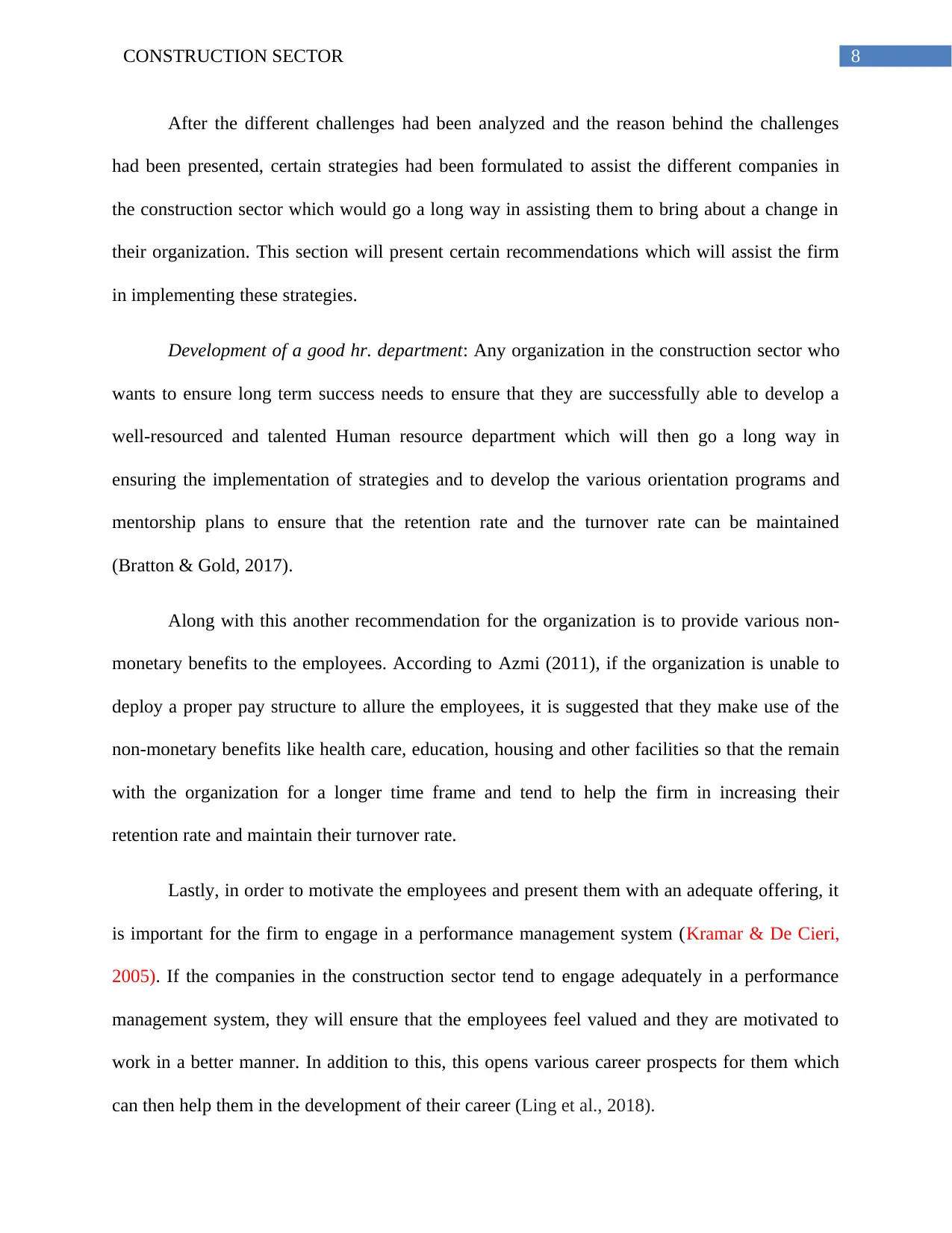
8CONSTRUCTION SECTOR
After the different challenges had been analyzed and the reason behind the challenges
had been presented, certain strategies had been formulated to assist the different companies in
the construction sector which would go a long way in assisting them to bring about a change in
their organization. This section will present certain recommendations which will assist the firm
in implementing these strategies.
Development of a good hr. department: Any organization in the construction sector who
wants to ensure long term success needs to ensure that they are successfully able to develop a
well-resourced and talented Human resource department which will then go a long way in
ensuring the implementation of strategies and to develop the various orientation programs and
mentorship plans to ensure that the retention rate and the turnover rate can be maintained
(Bratton & Gold, 2017).
Along with this another recommendation for the organization is to provide various non-
monetary benefits to the employees. According to Azmi (2011), if the organization is unable to
deploy a proper pay structure to allure the employees, it is suggested that they make use of the
non-monetary benefits like health care, education, housing and other facilities so that the remain
with the organization for a longer time frame and tend to help the firm in increasing their
retention rate and maintain their turnover rate.
Lastly, in order to motivate the employees and present them with an adequate offering, it
is important for the firm to engage in a performance management system (Kramar & De Cieri,
2005). If the companies in the construction sector tend to engage adequately in a performance
management system, they will ensure that the employees feel valued and they are motivated to
work in a better manner. In addition to this, this opens various career prospects for them which
can then help them in the development of their career (Ling et al., 2018).
After the different challenges had been analyzed and the reason behind the challenges
had been presented, certain strategies had been formulated to assist the different companies in
the construction sector which would go a long way in assisting them to bring about a change in
their organization. This section will present certain recommendations which will assist the firm
in implementing these strategies.
Development of a good hr. department: Any organization in the construction sector who
wants to ensure long term success needs to ensure that they are successfully able to develop a
well-resourced and talented Human resource department which will then go a long way in
ensuring the implementation of strategies and to develop the various orientation programs and
mentorship plans to ensure that the retention rate and the turnover rate can be maintained
(Bratton & Gold, 2017).
Along with this another recommendation for the organization is to provide various non-
monetary benefits to the employees. According to Azmi (2011), if the organization is unable to
deploy a proper pay structure to allure the employees, it is suggested that they make use of the
non-monetary benefits like health care, education, housing and other facilities so that the remain
with the organization for a longer time frame and tend to help the firm in increasing their
retention rate and maintain their turnover rate.
Lastly, in order to motivate the employees and present them with an adequate offering, it
is important for the firm to engage in a performance management system (Kramar & De Cieri,
2005). If the companies in the construction sector tend to engage adequately in a performance
management system, they will ensure that the employees feel valued and they are motivated to
work in a better manner. In addition to this, this opens various career prospects for them which
can then help them in the development of their career (Ling et al., 2018).
⊘ This is a preview!⊘
Do you want full access?
Subscribe today to unlock all pages.

Trusted by 1+ million students worldwide
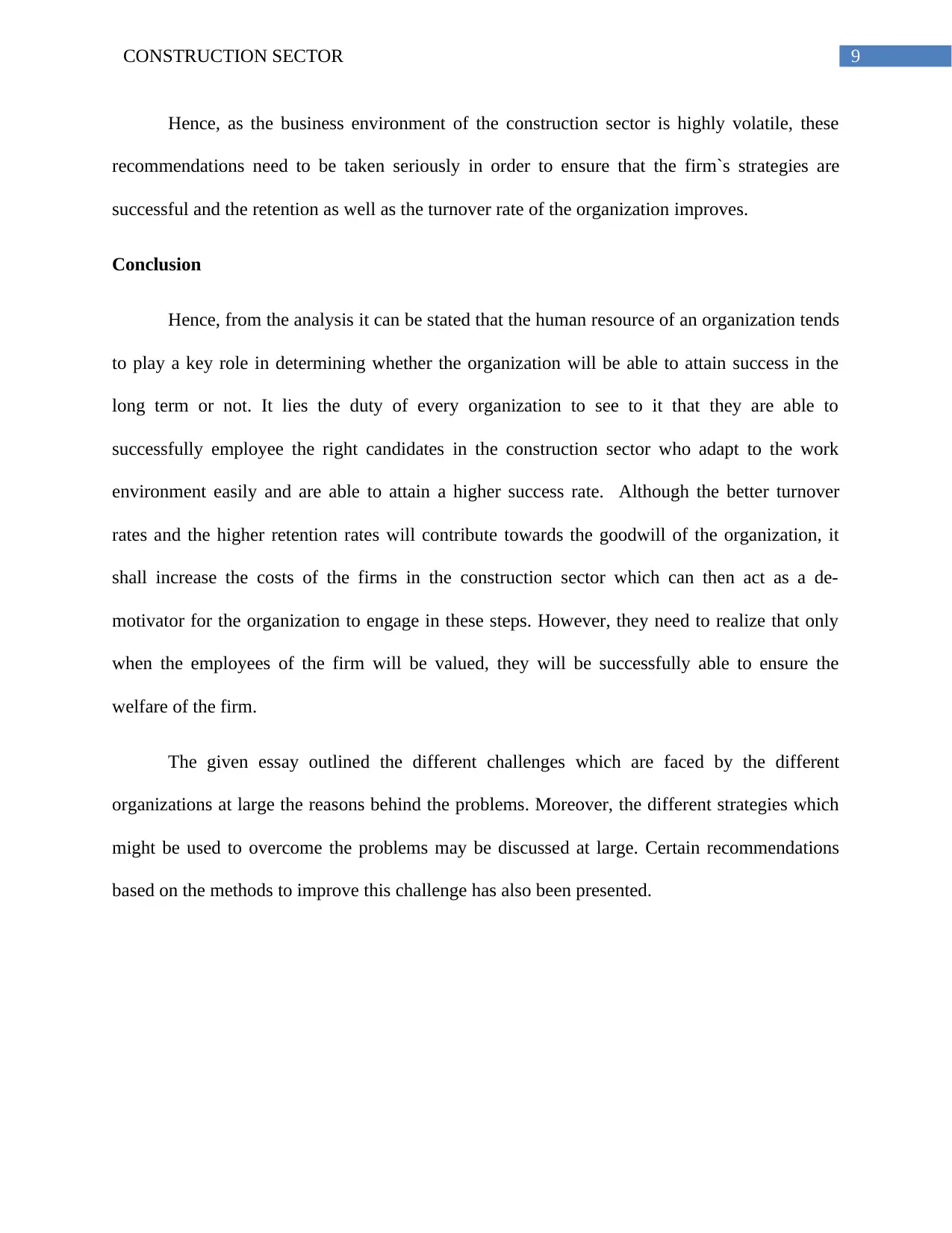
9CONSTRUCTION SECTOR
Hence, as the business environment of the construction sector is highly volatile, these
recommendations need to be taken seriously in order to ensure that the firm`s strategies are
successful and the retention as well as the turnover rate of the organization improves.
Conclusion
Hence, from the analysis it can be stated that the human resource of an organization tends
to play a key role in determining whether the organization will be able to attain success in the
long term or not. It lies the duty of every organization to see to it that they are able to
successfully employee the right candidates in the construction sector who adapt to the work
environment easily and are able to attain a higher success rate. Although the better turnover
rates and the higher retention rates will contribute towards the goodwill of the organization, it
shall increase the costs of the firms in the construction sector which can then act as a de-
motivator for the organization to engage in these steps. However, they need to realize that only
when the employees of the firm will be valued, they will be successfully able to ensure the
welfare of the firm.
The given essay outlined the different challenges which are faced by the different
organizations at large the reasons behind the problems. Moreover, the different strategies which
might be used to overcome the problems may be discussed at large. Certain recommendations
based on the methods to improve this challenge has also been presented.
Hence, as the business environment of the construction sector is highly volatile, these
recommendations need to be taken seriously in order to ensure that the firm`s strategies are
successful and the retention as well as the turnover rate of the organization improves.
Conclusion
Hence, from the analysis it can be stated that the human resource of an organization tends
to play a key role in determining whether the organization will be able to attain success in the
long term or not. It lies the duty of every organization to see to it that they are able to
successfully employee the right candidates in the construction sector who adapt to the work
environment easily and are able to attain a higher success rate. Although the better turnover
rates and the higher retention rates will contribute towards the goodwill of the organization, it
shall increase the costs of the firms in the construction sector which can then act as a de-
motivator for the organization to engage in these steps. However, they need to realize that only
when the employees of the firm will be valued, they will be successfully able to ensure the
welfare of the firm.
The given essay outlined the different challenges which are faced by the different
organizations at large the reasons behind the problems. Moreover, the different strategies which
might be used to overcome the problems may be discussed at large. Certain recommendations
based on the methods to improve this challenge has also been presented.
Paraphrase This Document
Need a fresh take? Get an instant paraphrase of this document with our AI Paraphraser
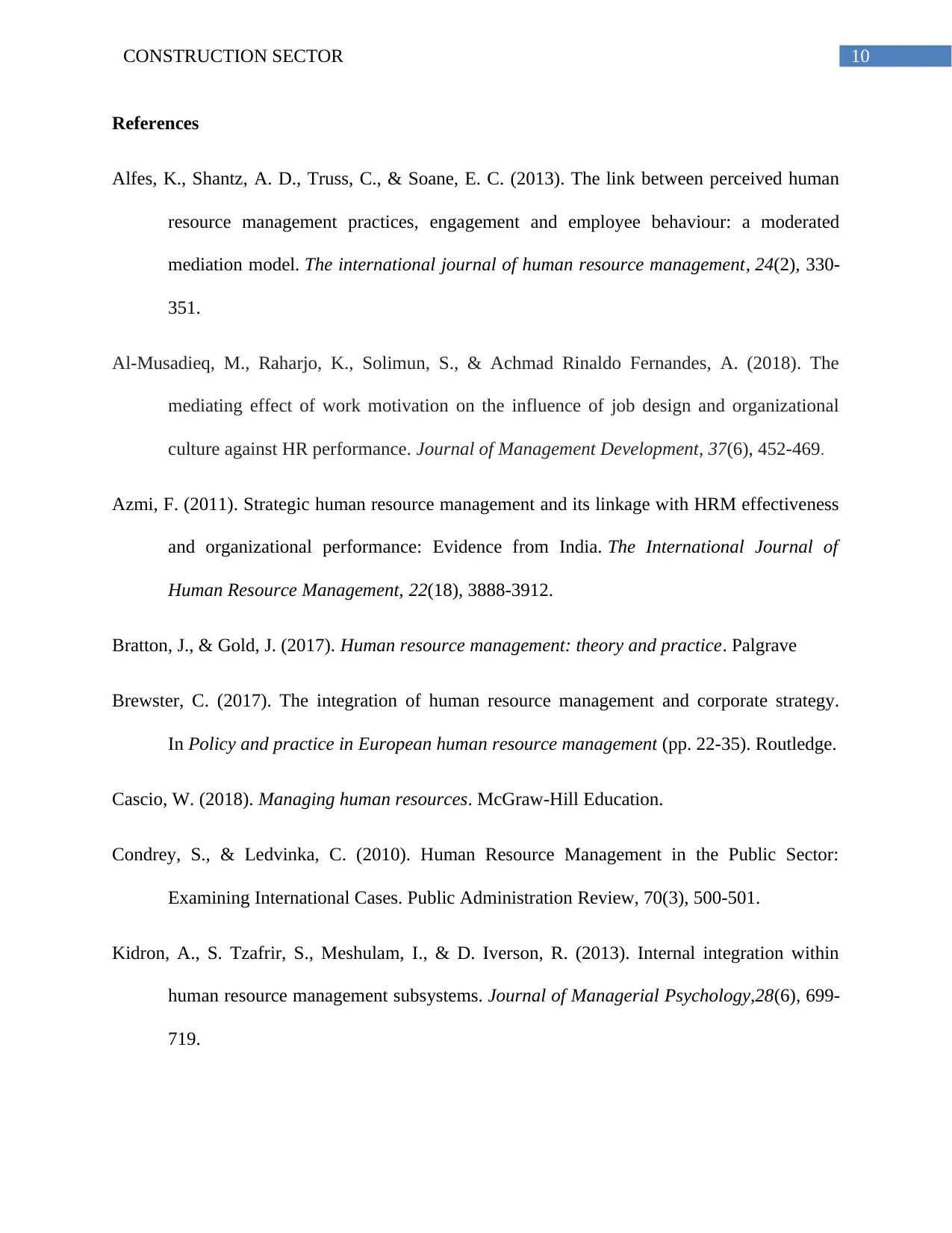
10CONSTRUCTION SECTOR
References
Alfes, K., Shantz, A. D., Truss, C., & Soane, E. C. (2013). The link between perceived human
resource management practices, engagement and employee behaviour: a moderated
mediation model. The international journal of human resource management, 24(2), 330-
351.
Al-Musadieq, M., Raharjo, K., Solimun, S., & Achmad Rinaldo Fernandes, A. (2018). The
mediating effect of work motivation on the influence of job design and organizational
culture against HR performance. Journal of Management Development, 37(6), 452-469.
Azmi, F. (2011). Strategic human resource management and its linkage with HRM effectiveness
and organizational performance: Evidence from India. The International Journal of
Human Resource Management, 22(18), 3888-3912.
Bratton, J., & Gold, J. (2017). Human resource management: theory and practice. Palgrave
Brewster, C. (2017). The integration of human resource management and corporate strategy.
In Policy and practice in European human resource management (pp. 22-35). Routledge.
Cascio, W. (2018). Managing human resources. McGraw-Hill Education.
Condrey, S., & Ledvinka, C. (2010). Human Resource Management in the Public Sector:
Examining International Cases. Public Administration Review, 70(3), 500-501.
Kidron, A., S. Tzafrir, S., Meshulam, I., & D. Iverson, R. (2013). Internal integration within
human resource management subsystems. Journal of Managerial Psychology,28(6), 699-
719.
References
Alfes, K., Shantz, A. D., Truss, C., & Soane, E. C. (2013). The link between perceived human
resource management practices, engagement and employee behaviour: a moderated
mediation model. The international journal of human resource management, 24(2), 330-
351.
Al-Musadieq, M., Raharjo, K., Solimun, S., & Achmad Rinaldo Fernandes, A. (2018). The
mediating effect of work motivation on the influence of job design and organizational
culture against HR performance. Journal of Management Development, 37(6), 452-469.
Azmi, F. (2011). Strategic human resource management and its linkage with HRM effectiveness
and organizational performance: Evidence from India. The International Journal of
Human Resource Management, 22(18), 3888-3912.
Bratton, J., & Gold, J. (2017). Human resource management: theory and practice. Palgrave
Brewster, C. (2017). The integration of human resource management and corporate strategy.
In Policy and practice in European human resource management (pp. 22-35). Routledge.
Cascio, W. (2018). Managing human resources. McGraw-Hill Education.
Condrey, S., & Ledvinka, C. (2010). Human Resource Management in the Public Sector:
Examining International Cases. Public Administration Review, 70(3), 500-501.
Kidron, A., S. Tzafrir, S., Meshulam, I., & D. Iverson, R. (2013). Internal integration within
human resource management subsystems. Journal of Managerial Psychology,28(6), 699-
719.
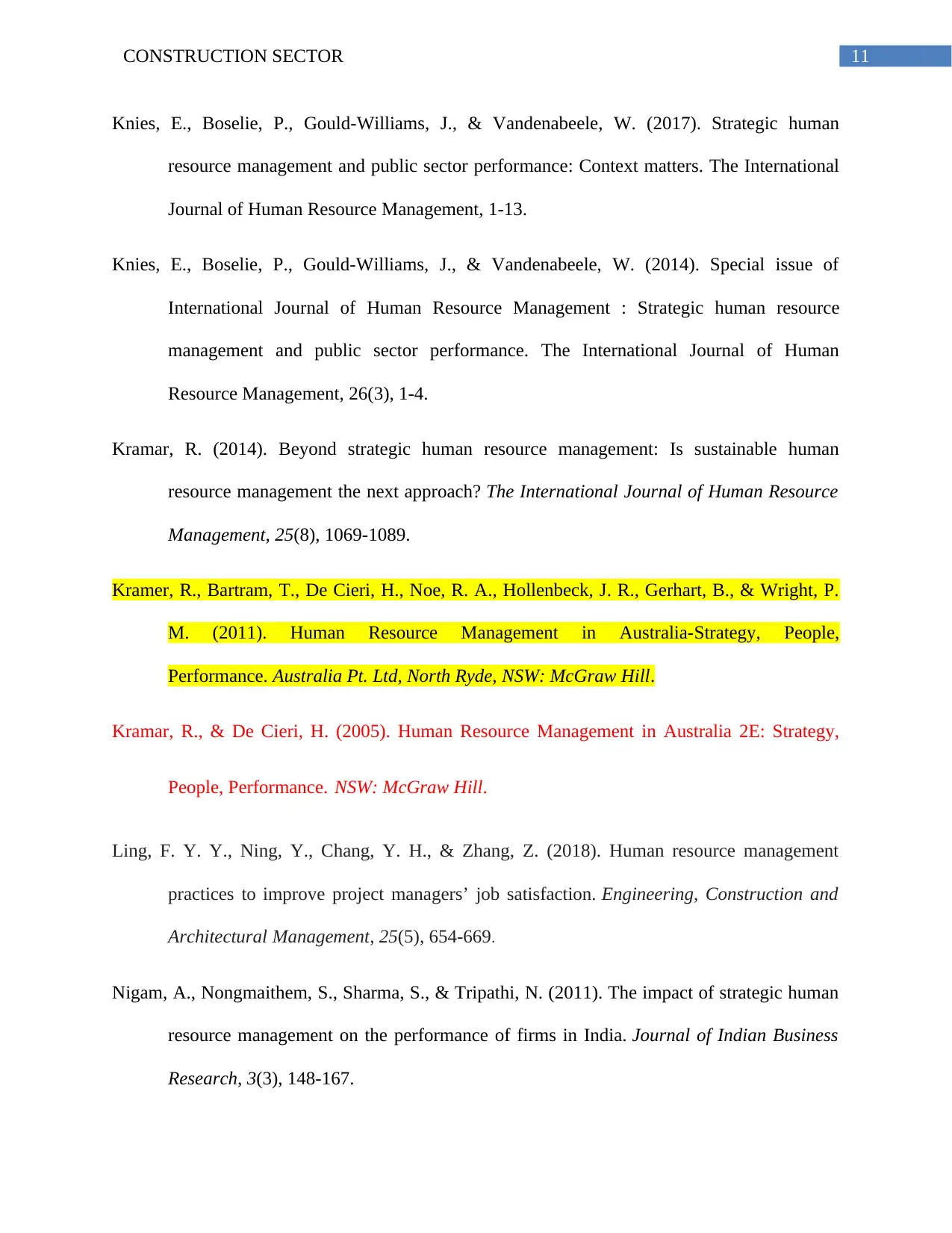
11CONSTRUCTION SECTOR
Knies, E., Boselie, P., Gould-Williams, J., & Vandenabeele, W. (2017). Strategic human
resource management and public sector performance: Context matters. The International
Journal of Human Resource Management, 1-13.
Knies, E., Boselie, P., Gould-Williams, J., & Vandenabeele, W. (2014). Special issue of
International Journal of Human Resource Management : Strategic human resource
management and public sector performance. The International Journal of Human
Resource Management, 26(3), 1-4.
Kramar, R. (2014). Beyond strategic human resource management: Is sustainable human
resource management the next approach? The International Journal of Human Resource
Management, 25(8), 1069-1089.
Kramer, R., Bartram, T., De Cieri, H., Noe, R. A., Hollenbeck, J. R., Gerhart, B., & Wright, P.
M. (2011). Human Resource Management in Australia-Strategy, People,
Performance. Australia Pt. Ltd, North Ryde, NSW: McGraw Hill.
Kramar, R., & De Cieri, H. (2005). Human Resource Management in Australia 2E: Strategy,
People, Performance. NSW: McGraw Hill.
Ling, F. Y. Y., Ning, Y., Chang, Y. H., & Zhang, Z. (2018). Human resource management
practices to improve project managers’ job satisfaction. Engineering, Construction and
Architectural Management, 25(5), 654-669.
Nigam, A., Nongmaithem, S., Sharma, S., & Tripathi, N. (2011). The impact of strategic human
resource management on the performance of firms in India. Journal of Indian Business
Research, 3(3), 148-167.
Knies, E., Boselie, P., Gould-Williams, J., & Vandenabeele, W. (2017). Strategic human
resource management and public sector performance: Context matters. The International
Journal of Human Resource Management, 1-13.
Knies, E., Boselie, P., Gould-Williams, J., & Vandenabeele, W. (2014). Special issue of
International Journal of Human Resource Management : Strategic human resource
management and public sector performance. The International Journal of Human
Resource Management, 26(3), 1-4.
Kramar, R. (2014). Beyond strategic human resource management: Is sustainable human
resource management the next approach? The International Journal of Human Resource
Management, 25(8), 1069-1089.
Kramer, R., Bartram, T., De Cieri, H., Noe, R. A., Hollenbeck, J. R., Gerhart, B., & Wright, P.
M. (2011). Human Resource Management in Australia-Strategy, People,
Performance. Australia Pt. Ltd, North Ryde, NSW: McGraw Hill.
Kramar, R., & De Cieri, H. (2005). Human Resource Management in Australia 2E: Strategy,
People, Performance. NSW: McGraw Hill.
Ling, F. Y. Y., Ning, Y., Chang, Y. H., & Zhang, Z. (2018). Human resource management
practices to improve project managers’ job satisfaction. Engineering, Construction and
Architectural Management, 25(5), 654-669.
Nigam, A., Nongmaithem, S., Sharma, S., & Tripathi, N. (2011). The impact of strategic human
resource management on the performance of firms in India. Journal of Indian Business
Research, 3(3), 148-167.
⊘ This is a preview!⊘
Do you want full access?
Subscribe today to unlock all pages.

Trusted by 1+ million students worldwide
1 out of 13
Related Documents
Your All-in-One AI-Powered Toolkit for Academic Success.
+13062052269
info@desklib.com
Available 24*7 on WhatsApp / Email
![[object Object]](/_next/static/media/star-bottom.7253800d.svg)
Unlock your academic potential
Copyright © 2020–2025 A2Z Services. All Rights Reserved. Developed and managed by ZUCOL.




